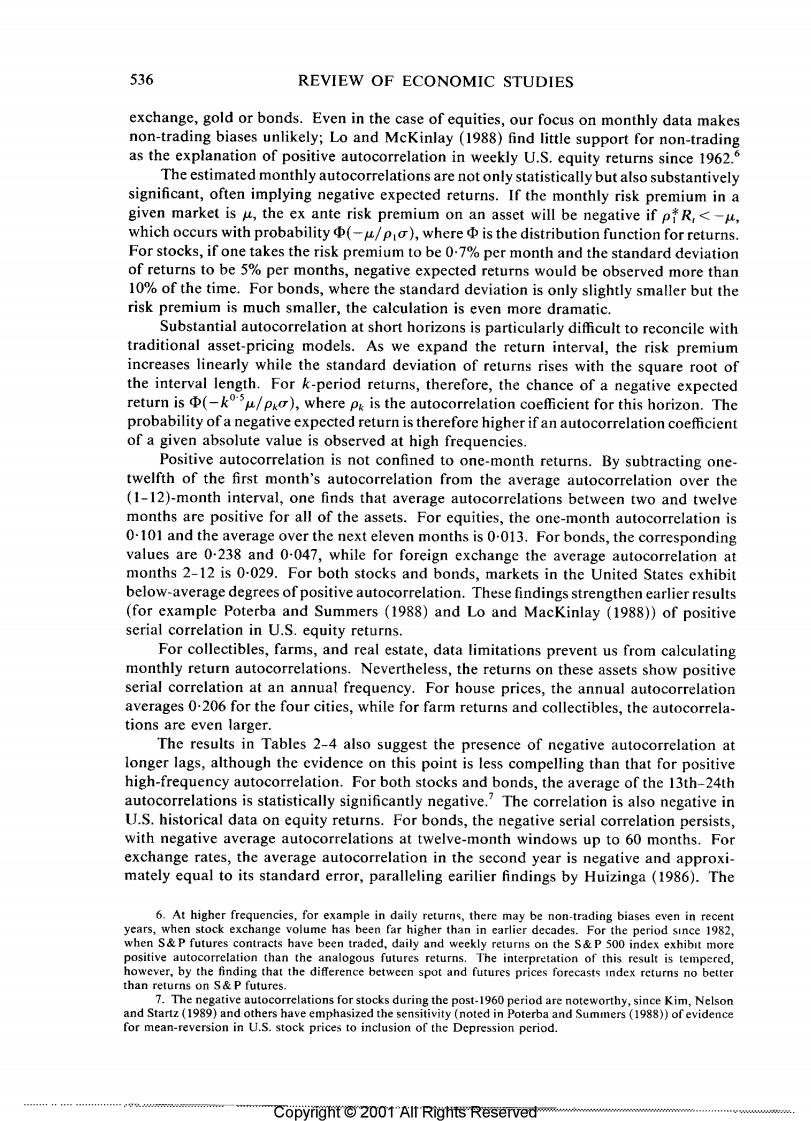正在加载图片...

536 REVIEW OF ECONOMIC STUDIES exchange,gold or bonds.Even in the case of equities,our focus on monthly data makes non-trading biases unlikely;Lo and McKinlay (1988)find little support for non-trading as the explanation of positive autocorrelation in weekly U.S.equity returns since 1962. The estimated monthly autocorrelations are not only statistically but also substantively significant,often implying negative expected returns.If the monthly risk premium in a given market is u,the ex ante risk premium on an asset will be negative if pR,<-u, which occurs with probability (-u/p )where is the distribution function for returns For stocks,if one takes the risk premium to be 0.7%per month and the standard deviation of returns to be 5%per months,negative expected returns would be observed more than 10%of the time.For bonds,where the standard deviation is only slightly smaller but the risk premium is much smaller,the calculation is even more dramatic. Substantial autocorrelation at short horizons is particularly difficult to reconcile with traditional asset-pricing models.As we expand the return interval,the risk premium increases linearly while the standard deviation of returns rises with the square root of the interval length.For k-period returns,therefore,the chance of a negative expected return is(-k/p),where p is the autocorrelation coefficient for this horizon.The probability of a negative expected return is therefore higher if an autocorrelation coefficient of a given absolute value is observed at high frequencies. Positive autocorrelation is not confined to one-month returns.By subtracting one- twelfth of the first month's autocorrelation from the average autocorrelation over the (1-12)-month interval,one finds that average autocorrelations between two and twelve months are positive for all of the assets.For equities,the one-month autocorrelation is 0.101 and the average over the next eleven months is 0-013.For bonds,the corresponding values are 0.238 and 0-047,while for foreign exchange the average autocorrelation at months 2-12 is 0-029.For both stocks and bonds,markets in the United States exhibit below-average degrees of positive autocorrelation.These findings strengthen earlier results (for example Poterba and Summers (1988)and Lo and MacKinlay (1988))of positive serial correlation in U.S.equity returns. For collectibles,farms,and real estate,data limitations prevent us from calculating monthly return autocorrelations.Nevertheless,the returns on these assets show positive serial correlation at an annual frequency.For house prices,the annual autocorrelation averages 0-206 for the four cities,while for farm returns and collectibles,the autocorrela- tions are even larger. The results in Tables 2-4 also suggest the presence of negative autocorrelation at longer lags,although the evidence on this point is less compelling than that for positive high-frequency autocorrelation.For both stocks and bonds,the average of the 13th-24th autocorrelations is statistically significantly negative.The correlation is also negative in U.S.historical data on equity returns.For bonds,the negative serial correlation persists, with negative average autocorrelations at twelve-month windows up to 60 months.For exchange rates,the average autocorrelation in the second year is negative and approxi- mately equal to its standard error,paralleling earilier findings by Huizinga(1986).The 6.At higher frequencies,for example in daily returns,there may be non-trading biases even in recent years,when stock exchange volume has been far higher than in earlier decades.For the period since 1982, when S&P futures contracts have been traded,daily and weekly returns on the S&P 500 index exhibit more positive autocorrelation than the analogous futures returns.The interpretation of this result is tempered, however,by the finding that the difference between spot and futures prices forecasts index returns no better than returns on S&P futures. 7.The negative autocorrelations for stocks during the post-1960 period are noteworthy,since Kim,Nelson and Startz (1989)and others have emphasized the sensitivity (noted in Poterba and Summers(1988))of evidence for mean-reversion in U.S.stock prices to inclusion of the Depression period. Copynight 2001 All Rights ReservedR